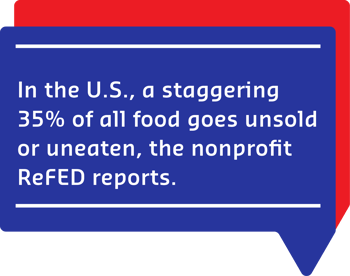Let’s Talk Food Recovery! America’s Other Food Pyramid
Growing up, many of us learned healthy eating through the Food Pyramid, which illustrates the number of servings we should eat every day from basic food groups.
Fewer people have seen the Food Recovery Hierarchy pyramid, an inverted triangle showing how to reduce food loss and waste. And few probably understand this waste is a massive global issue.
 In the U.S., a staggering 35% of all food goes unsold or uneaten, the nonprofit ReFED reports.
In the U.S., a staggering 35% of all food goes unsold or uneaten, the nonprofit ReFED reports.
About one-third of food raised or prepared globally goes uneaten, wasting everything from seeds and water to energy, labor and money, according to Project Drawdown, a nonprofit dedicated to assessing the best ways to address climate change. Food waste also accounts for about 8% of global carbon emissions.
Project Drawdown identifies food waste as one of the top three issues driving climate change. So, reducing loss and waste is one of the most important things individuals, governments and businesses can do for the environment.
Nell Fry, Director of Sustainability and Corporate Social Responsibility for Sodexo North America says:
"The amount of food we waste is reliably upsetting to most people."
Sodexo is first and foremost a food company, so this issue is close to our heart.
We have disclosed our food waste and loss footprint — 117,000 metric tons annually in 2019. We’re committed to reducing this waste 50% by 2025 through our 9 Corporate Social Responsibility Commitments.
We believe it’s part of excelling at what we do. Reducing food waste and loss is the right thing to do from every perspective — environmental, social and financial.
So, how are we tackling this problem?
We are focused on source reduction and feeding hungry people, Levels 1 and 2 of the Food Recovery Hierarchy.
Level 1: Source Reduction
We prioritize source reduction — not buying more food than we can use — because it’s just good business and the best way to address the problem overall.
Our key weapon is WasteWatch powered by Leanpath. This innovative program uses a scale and tablet to weigh food that is wasted in any of eight ways, including overproduction, user error (such as burning) or spoilage. Chefs can track waste and project how much will be wasted over time if nothing changes. They can also project the cost and set email alerts regarding certain values and types of food waste. The data they collect can be used to create more efficient orders, provide more effective training to employees and develop better food management procedures.
Fry remembers one site that found it was wasting a lot of fish because it was cooked in big batches and sat out. Guests would bypass the food and wait for a fresh dish, leading to the older fish getting tossed. By tracking the waste, the kitchen decided to cook in smaller, more frequent batches. The outcome? Tastier dishes, happy customers, money saved and less waste.
We also participate in global initiatives and coalitions committed to cutting food loss and waste in half by 2030 at Sodexo and along our supply chain, such as Champions 12.3 and 10x20x30.
In addition, our food loss and waste reduction targets are tied to financial outcomes – a 1.3 billion Euro loan with interest rates tied to performance, as well as senior leader compensation and bonuses.
Level 2: Feed Hungry People
Feeding Hungry People is our other focus. Since 1996, we have fed millions through our Stop Hunger Foundation, which partners with organizations to donate edible overstock food to families in need. It also provides grants and mobilizes our employee volunteers to fight hunger.
One of our key community partners is the Food Recovery Network, a BIPOC/female-led organization that engages university student volunteers to recover and donate food. Fifty-one universities currently have active FRN student chapters in place with support from Sodexo employees.
In addition, SodexoMagic — a partnership between majority-owner Magic Johnson Enterprises and Sodexo — works with Goodr, a woman-owned, minority-led food recovery organization. Goodr provides healthy food to families in need through recovered and donated food, as well as free pop-up groceries. It also redirects inedible food waste to compost sites instead of landfills, hitting three of the five recovery opportunities in the food recovery hierarchy.
These are just a couple of our key partnerships; we are currently working to expand these programs through additional partnerships and initiatives.
Making Progress
Fry says the key to tackling the food loss and waste crisis is acknowledging there’s no silver bullet. The “solutions” will be a patchwork of creative interventions and on-site innovations, aligned with global commitments. Problems must be addressed companywide, at the sources, recognizing necessary trade-offs.
The good news? More operators are recognizing the value of reducing food waste.
"The pushback has really changed," Fry says. "It used to be, what’s the ROI? It used to be considered a ‘nice to have.’ Now, our leadership and operators understand the value that goes beyond just ROI."
The need to manage budgets against rising food, fuel and labor costs has motivated buy-in. Employees also appreciate working for a company that wastes less and shares more.
About 1,000 Sodexo USA sites have implemented waste reduction measures.
We’re making good progress. In fact, we were recently recognized by the U.S. Environmental Protection Agency as a Food Recovery Challenge leader in diverting food waste from landfills.
Now, we want to activate more sites. "We are expanding and putting new, innovative solutions and methodologies in place," Fry says. "The train is moving."